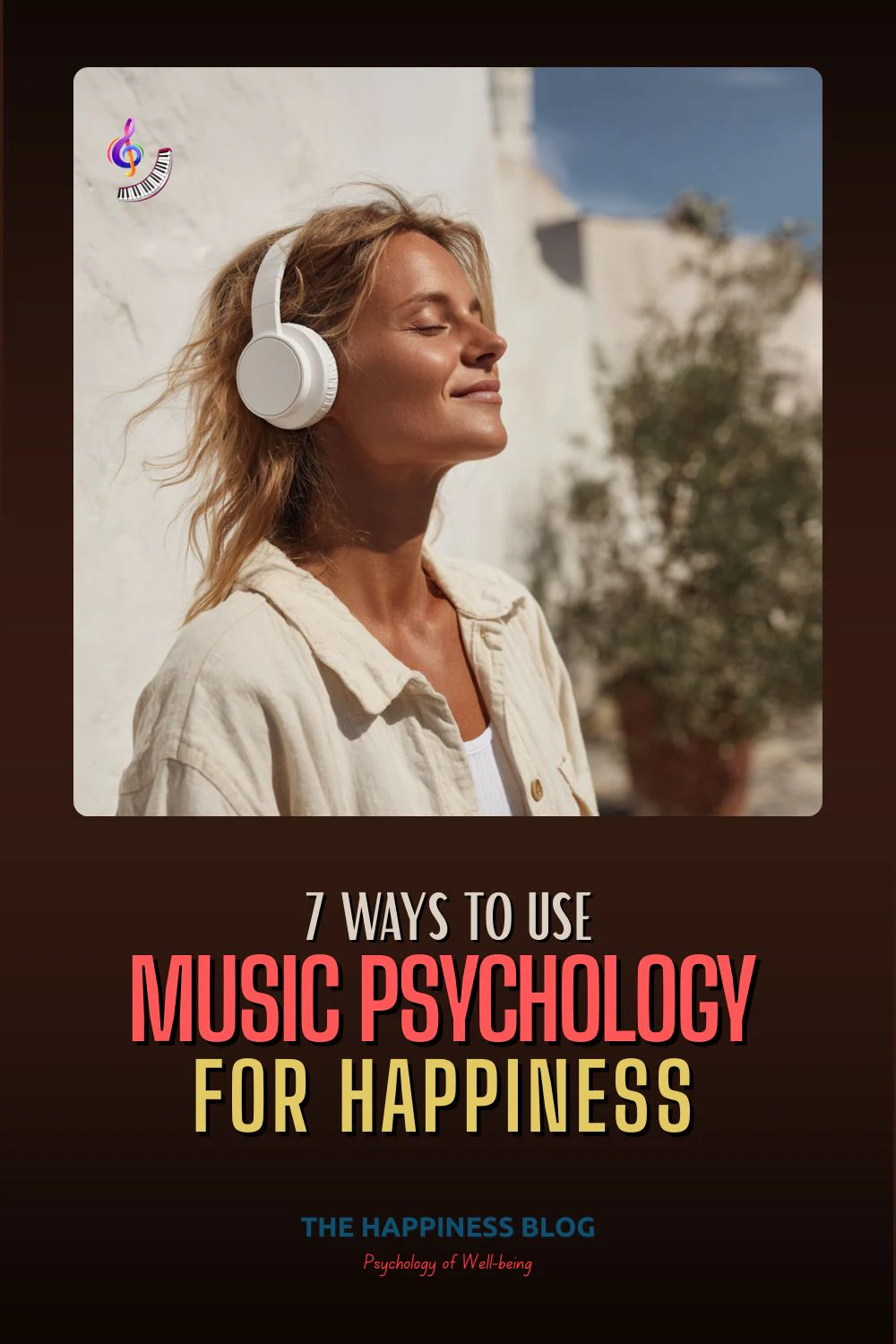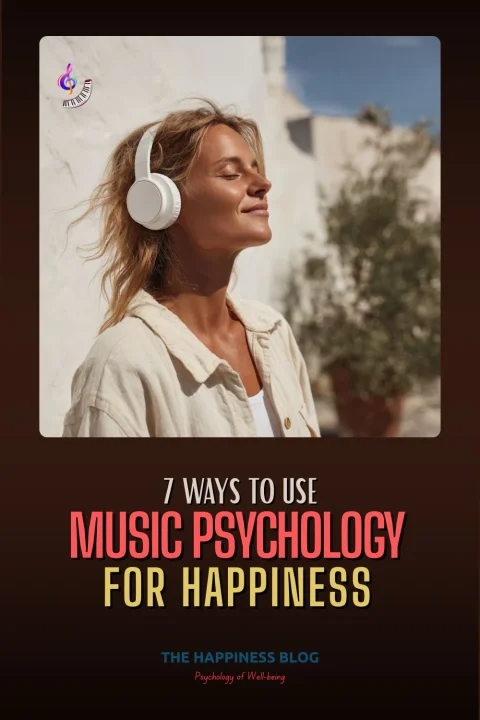Today's Thursday • 8 mins read
— By Dr. Sandip Roy.
Music can change your mood within seconds.
Brain imaging studies show that listening to music activates the same reward circuits triggered by laughter, affection, or good food.
During emotionally charged moments in a song, dopamine release peaks, creating that rush of pleasure people describe as chills. A single track can calm your heartbeat, lift energy, or bring back vivid memories.
Modern psychology now treats music as more than art. A simple, science-based tool for mental health. Regular listening can lift mood, lower stress hormones, and strengthen social bonds.
You don’t need musical skill to benefit. What matters is listening with intention and purpose.
“Music can change the world because it can change people.” — Bono, U2
7 Ways to Use Music Psychology For Happiness
These research-backed practices make your music listening more enjoyable.
1. Use intention-based playlists.
Neuroscientist Valorie Salimpoor’s work shows that dopamine spikes during musical “chills,” producing pleasure similar to food, laughter, or affection. That reward response strengthens when you listen with intent.
A study by Ferguson & Sheldon found that 12 minutes of upbeat music improved mood only when participants intended to feel happier. So before you hit play, decide what you want from the session: relaxation, focus, or uplift.
Emotional response also depends on structure, not just lyrics.
Stefan Koelsch‘s research shows that consonant harmonies create a sense of safety, while dissonant tones signal tension. Across cultures, major keys and rising melodies are linked with vitality and joy.
Choose tracks built around those features when you want a dependable mood lift.

2. Time your sessions.
Music triggers learned links between the sound and the mood. Regular listening strengthens those associations.
So, short, consistent sessions are better than random listening.
- Ten minutes of calm music before bed helps slow breathing and supports deeper sleep.
- Morning playlists with moderate tempo (90–110 bpm) ease the transition into alert focus.
3. Try communal music.
Singing or moving with others releases endorphins and oxytocin, which elevate mood and strengthen connection.
Studies on choirs, drumming circles, and dance groups show that shared rhythm promotes bonding and collective happiness. When people sing or move together, their breathing and heart rate often synchronize, showing a measurable sign of emotional unity.
Whether it’s a local choir, a casual jam, or a dance session with friends on video, shared music amplifies the reward response.
Families who sing or play together often report better emotional attunement and a stronger sense of belonging.
4. Combine movement with music.
Dance, stretch, or walk to a rhythm.
Pairing rhythm and motion activates more reward pathways than listening alone. Exercise studies show higher dopamine and endorphin levels when activity is set to a rhythm, along with improved motivation and stress recovery.
Match tempo to the goal: faster beats for cardio, slower ones for yoga or stretching. Even short dance or drumming breaks can reset energy and improve mood.
5. Be mindful of emotional contagion.
Sad music can be cathartic, but avoid hearing it on repeat.
Repetitive listening to songs tied to painful memories can reinforce rumination or overthinking. People who are prone to depression sometimes use music to dwell on loss rather than resolve it.
Music communicates emotion directly, bypassing language. That’s powerful, but not always positive. Sad or tense music can validate emotion in the short term, yet extend a low mood if played repeatedly.
Use reflective tracks to acknowledge feelings, then transition to neutral or upbeat music once you’ve processed them.
Pay attention to how you feel after each session. The goal is regulation, not indulgence.
6. Protect your hearing.
Long-term exposure to loud sound elevates stress hormones and can damage the inner ear, dulling music’s natural reward response.
Keep volume under 70% of your device’s maximum, and take breaks when using headphones. Safe listening preserves both hearing and the pleasure of music over time.
7. Use technology wisely.
Streaming platforms learn your preferences and may reinforce certain moods. Check your “mood” playlists periodically and replace tracks that no longer fit how you want to feel.
Balance algorithmic suggestions with intentional curation. Create personal lists labeled Calm, Energize, and Reset for quick emotional alignment without endless scrolling.
Used intentionally, music becomes more than background sound. It becomes a daily way to train the brain toward reward, calm, and connection.
Music As A Source of Happiness
Music influences happiness in measurable ways. Listening or making music can raise mood, lower stress hormones, and increase feelings of connection (Juslin & Västfjäll, 2008; Koelsch, 2015; Thaut & Hoemberg, 2014; Zatorre, 2015).
Researchers have repeatedly shown that both passive listening and active participation stimulate positive emotion and a sense of reward.
A 2019 meta-analysis of hundreds of trials found that calming music consistently reduced cortisol, blood pressure, and perceived anxiety (De Witte & Spruit, 2019). The benefits appeared across diverse groups, from patients awaiting surgery to healthy adults using playlists at home.
When stress decreases, subjective well-being tends to rise, and that physiological shift helps explain why regular music exposure feels uplifting.
Short sessions work well. Ten to fifteen minutes of slow, rhythmic music can regulate breathing and trigger the same relaxation response observed in mindfulness. Many hospitals now include personalized playlists in recovery care for pain and anxiety relief.
At home, you can use the same principle to elevate your mood. Choose tracks that match your current state and guide you gradually toward calm or energy.
One useful guideline: tempo matters: slower rhythms (60–80 beats per minute) align with the body’s resting heart rate and cue the nervous system to relax.
When you want to relax or have emotional balance, instrumental or low-lyric pieces often work the best.
Over time, these small sessions build an association between certain sounds and a sense of comfort or optimism. That learned link is one reason music can become a reliable source of everyday happiness.
How Music Changes The Brain
When we enjoy a song, several brain regions synchronize: the auditory cortex processes sound, the limbic system handles emotion, and the striatum releases dopamine.
Neuroscientist Valorie Salimpoor’s research found that dopamine spikes during musical “chills,” giving measurable pleasure similar to food or sex. This is why people replay songs obsessively and why music often accompanies celebration or exercise.
Over time, repeated listening can build conditioned links between sound and mood. That’s why playlists can be used strategically to reset energy levels or prepare for a task.
Try This Today
- Pick one short track that reliably lifts your mood.
- Sit comfortably, close your eyes, and breathe with the rhythm for three minutes. Notice any shift in tension or alertness.
- Then choose a calm track for evening wind-down. Small, deliberate steps build consistency, which matters more than playlist length.
Studies & Scientific References:
- Ferguson, Y. L., & Sheldon, K. M. (2013). “Trying to be happier really can work: Two experimental studies.” The Journal of Positive Psychology.
- Blood, A. J., & Zatorre, R. J. (2001). Intensely pleasurable responses to music correlate with activity in brain regions implicated in reward and emotion. Proceedings of the National Academy of Sciences
- Salimpoor, V. N., Benovoy, M., Larcher, K., Dagher, A., & Zatorre, R. J. (2011). Anatomically distinct dopamine release during anticipation and experience of peak emotion to music. Nature Neuroscience
- Menon, V., & Levitin, D. J. (2005). “The rewards of music listening: Response and physiological connectivity of the mesolimbic system.” NeuroImage.
- Juslin, P. N., & Västfjäll, D. (2008). “Emotional responses to music: The need to consider underlying mechanisms.” Behavioral and Brain Sciences.
- Koelsch, S. (2014). “Brain correlates of music-evoked emotions.” Nature Reviews Neuroscience.
- Chanda, M. L., & Levitin, D. J. (2013). “The neurochemistry of music.” Trends in Cognitive Sciences.
- de Witte, M., Spruit, A., van Hooren, S., Moonen, X., & Stams, G. J. (2020). “Effects of music interventions on stress-related outcomes: a systematic review and two meta-analyses.” Health Psychology Review.
- MacDonald, R., Kreutz, G., & Mitchell, L. (2012). Music, Health, and Wellbeing. Oxford University Press.
- Clarke, E. F., Dibben, N., & Pitts, S. E. (2010) – Music and Mind in Everyday Life. Oxford University Press.
- Thoma, M. V., Ryf, S., Mohiyeddini, C., Ehlert, U., & Nater, U. M. (2013). “Emotion regulation through listening to music in everyday situations.” Cognition & Emotion.
- Garrido, S., & Schubert, E. (2011). “Negative emotions in music: What’s the use?” Music Perception.
- Vuoskoski, J. K., & Eerola, T. (2017). “The pleasure evoked by sad music: A meta-analysis.” Frontiers in Psychology.
- Linnemann, A., Kappert, M. B., Fischer, S., Doerr, J. M., Strahler, J., & Nater, U. M. (2015). “The stress-reducing effect of music listening varies depending on the social context.” Psychoneuroendocrinology.
- Blood, A. J., & Zatorre, R. J. (2001). “Intensely pleasurable responses to music correlate with activity in brain regions implicated in reward and emotion.” PNAS.
- Huron, D. (2006). Sweet Anticipation: Music and the Psychology of Expectation. MIT Press.
Final Words
Music connects body, brain, and community in ways few activities can. When used intentionally, music can help you manage stress, recover emotional balance, and feel more connected.
In a noisy world, listening on purpose might be the simplest happiness practice we have.
√ Also Read: 10 Ways To Be Happy In Daily Life: Expert Tips From Science
√ Please share it with someone if you found this helpful.
